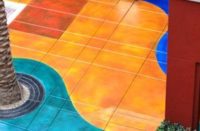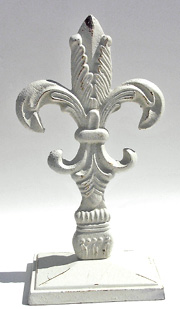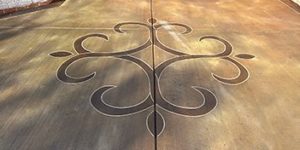
I have written about how a compass rose changed my world. Subsequently, I became obsessed with different ways to make medallions, such as fleur-de-Lis on concrete. To me, a medallion is any centralized image that becomes a room’s focal point. I’m going to reiterate this more and more in upcoming articles. My concrete life might have started with a compass rose but before I knew it I despised them.
They were so easy to make that I soon tired of them. This quickly began to work to my advantage though. In a sales call, every other concrete contractor was offering a compass rose. I began to offer everything but one and quickly began to stand out from a design perspective. A relatively simple design, a compass rose can be produced by most contractors. You can even buy a prefabricated stamp for your projects. And if you install tile, you can go to Home Depot and buy a tile that has a medallion as part of the design.
In this wide world of decorative concrete, we need to find ways to stand out. Just being a competent contractor who can produce a compass rose on concrete won’t help you do that. You need to have many medallion designs in your portfolio to show how far you can take a project. Once you have those you can truly stand out in a crowd of decorative concrete contractors.
Good for a French flair
A fleur-de-lis is a great next step in building that portfolio. There are so many variations to this image that it’s hard to get bored doing them. Thanks to the New Orleans Saints football team, everyone knows what this image looks like.
While the fleur-de-lis has appeared on countless European coats of arms and flags over the centuries, it’s particularly associated historically with the French monarchy. The three petals represent the medieval social classes: those who worked, those who fought and those who prayed.
Be careful not to use this image too much because with its French roots it won’t fit every house’s decor. For example, I don’t think it would look good at a Spanish villa. During my initial sales calls with clients, I pay close attention to their home’s decor. If I see wrought-iron work or images that have a slight fleur-de-lis look to them then I will bring it up. If the house has a Spanish influence, I dismiss the fleur-de-lis for that project.
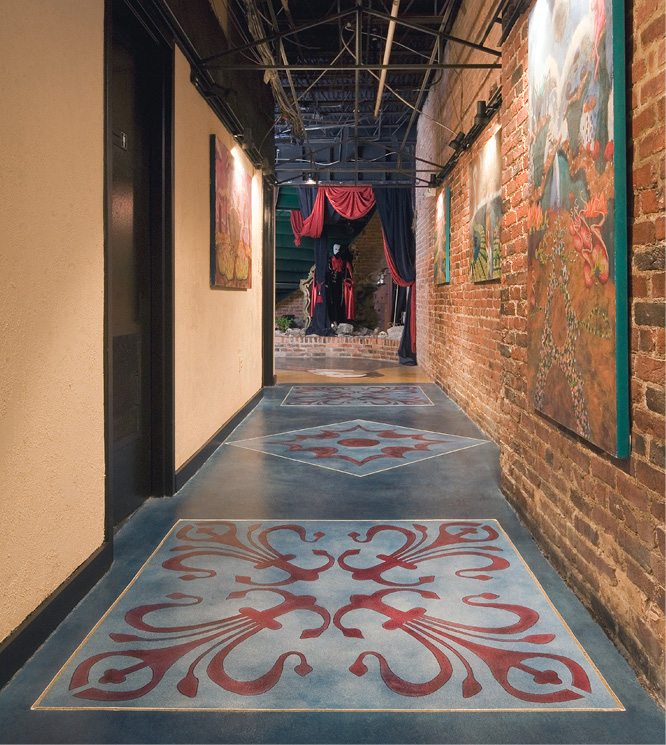
A fitting design if it fits
One of the most important points to my concrete design work, or specifically the sale of the project, is the sold design must fit the house. It should look like it was there from the initial architect’s or designer’s conception. I cannot stress this point enough.
These days because of my extensive portfolio, I gain clients’ trust by finding what they want. Clients always ask me what I would do or want to do. As much as they think they care about what I want, they really don’t. Most clients can’t afford what I “want” to do.
Instead of focusing on my particular wants, I look for what they find appealing. Once I find an image they like, I run with it. I encourage you to have many different types of medallions in your portfolio because you need to prove you can pull off any number of designs.
It took me years of drawing out designs to get the portfolio I have today. I doubt there’s a contractor in my town that can successfully produce a third of my designs. Most of my clients take a look at my website and say, “I didn’t know there were this many possibilities with concrete.” I gain clients’ respect and trust quickly and keep it once I create a design based on their input.
 Half and half
Half and half
I started using fleur-de-lis slowly because, like I’ve said, it doesn’t fit every house. Nowadays, I use variations of it in my medallions (more on that next issue).
For now, let’s break down how to layout a fleur-de-lis. Like the compass rose, I start with a big X in the center of the floor. The first thing I do for this type of medallion is frame it with a circle border. This helps define the size of the fleur-de-lis and helps you visualize an end product. If you create a circle first, you won’t waste time when it comes to drawing the entire medallion.
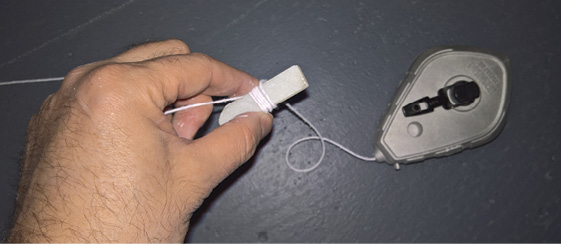 A circle takes seconds to draw if you take your chalk line and use it as a string. Wrap a generous amount of string around a piece of soapstone and then spin in a circle keeping the other end of the string on the center point. Then make a circle within the circle, creating a round border. It will frame the fleur-de-lis nicely. In my video for this project I made a 5-inch-wide border. The outside circle is 7 foot in diameter.
A circle takes seconds to draw if you take your chalk line and use it as a string. Wrap a generous amount of string around a piece of soapstone and then spin in a circle keeping the other end of the string on the center point. Then make a circle within the circle, creating a round border. It will frame the fleur-de-lis nicely. In my video for this project I made a 5-inch-wide border. The outside circle is 7 foot in diameter.
 Once you have the border laid out, plan the size of the fleur-de-lis. I left a 7-inch gap between the border and the fleur-de-lis. Now comes the tricky part, drawing the fleur-de-lis. First, draw half of it before trying to accurately mimic the drawing for the other half. Adjustments can be made at any time but try to get that first side as close to perfect as possible. This is where you should practice how to draw that perfect curve. You aren’t going to get it right on the first attempt. Just wipe off and adjust until you feel you have the first half the way you want it.
Once you have the border laid out, plan the size of the fleur-de-lis. I left a 7-inch gap between the border and the fleur-de-lis. Now comes the tricky part, drawing the fleur-de-lis. First, draw half of it before trying to accurately mimic the drawing for the other half. Adjustments can be made at any time but try to get that first side as close to perfect as possible. This is where you should practice how to draw that perfect curve. You aren’t going to get it right on the first attempt. Just wipe off and adjust until you feel you have the first half the way you want it.
Once you get the first half to your liking, start plotting points for the other half. Plot as many points as necessary. I plot the farthest outside edges of the image and where the tips land. Then follow those points and draw the other half of the image. They will not look exact the first time.
Sometimes I like the second half better than the first and go back and make minor adjustments to it. These plot points are a guide. The more you make, the more exact you will get. In my next article, I’m going to take an in-depth look at how to plot points properly on concrete.
Remember that a fleur-de-lis has three sections — for those who worked, fought and prayed. Now you can finish off your curves and separate it into three different parts. At this point, I realized the tips of the center were too plain. I adjusted those tips and finished the image. I now can use the existing shape to my advantage to keep everything centered and consistent.
Now you have a basic fleur-de-lis on concrete. Once you master it, you can start getting creative with more complex versions. Like I always say, keep it simple at first.

